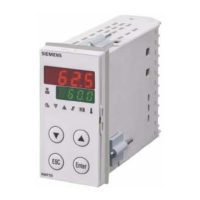42/126
Siemens Building Technologies Basic documentation RVD240 CE1P2384en
HVAC Products 12 Function block Space heating 27.05.2004
2462D06
S
Impact of the room temperature setpoint change on the flow temperature setpoint
∆w
R
Change of room temperature setpoint
s Heating curve slope
∆w
VT
Change of flow temperature setpoint
The flow temperature setpoint change ∆w
VT
is calculated according to the following
formula:
∆w
VT
= ∆w
R
× ( s × 0.1 + 1 )
12.3 Heating curve
With both types of weather-compensated flow temperature control (with / without room
temperature influence), the heating curve ensures the assignment of the flow tempera-
ture setpoint to the outside temperature. Its slope for each heating circuit is to be set
separately on operating line 5.
T
AM
T
V
s
=
2381D05
110
100
90
80
70
60
50
40
30
20
20
15 10
5
0
-5
-10
-15
-20
-25 -30 -35
40 35 32,5 30
27,5
25 22,5
20
17,5
15
12,5
10
7,5
5
2,5
Heating curve
s Slope
T
AM
the composite outside temperature
T
V
Flow temperature
The heating curve has a fixed tilting point at an outside temperature of 22 °C and a flow
temperature of 20 °C. It can be set around this tilting point in the range from 2.5 to 40 in
increments of 0.5.
Each heating curve has a substitute line which intersects the tilting point and ”its” heat-
ing curve at an outside temperature of 0 °C. Its slope is set on the controller and is cal-
culated as follows:
10 ×
∆T
V
s =
∆T
AM
The use of a substitute line is required because the heating curve is slightly deflected.
This is necessary to compensate for the nonlinear radiation characteristics of the differ-
ent types of radiators.

